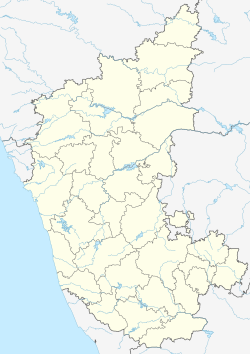Bhatkala
|
Bhatkal ಭಟ್ಕಳ |
|
|---|---|
| Town | |
| Location in Karnataka, India | |
| Coordinates: 13°58′01″N 74°34′01″E / 13.967°N 74.567°ECoordinates: 13°58′01″N 74°34′01″E / 13.967°N 74.567°E | |
| Country |
|
| State | Karnataka |
| District | Uttara Kannada |
| Government | |
| • Type | Town Municipal Council |
| Area | |
| • Total | 355.50 km2 (137.26 sq mi) |
| Elevation | 3 m (10 ft) |
| Population (2011) | |
| • Total | 161,576 (Taluk) |
| Languages | |
| • Official | Kannada |
| Time zone | IST (UTC+5:30) |
| PIN | 581 320 |
| Telephone code | +91-8385 |
| Vehicle registration | KA-47 |
Bhatkal, also known as 'Batecala' in some historical Portuguese texts, is a port town in the Uttara Kannada District of the South Indian state of Karnataka. The town of Bhatkal lies on National Highway 66, which runs between Mumbai and Kochi, and has one of the major railway stations along the Konkan Railway line, which runs between Mumbai and Mangaluru.
In its early days, Bhatkal belonged to followers of the Jain and Hindu religions and later acquired more religions and cultures. Bhatkal gets its name from the Jain Grammarian Bhattakalanka, who hailed from Haduvalli village. It is a town located on the shores of the Arabian Sea, with Sharavathi river few miles to its north. Bhatkal's location, although very strategic, was the main factor behind the erratic history of the countryside in the area. Bhatkal witnessed the rise and fall of several dynasties and rulers. It was a part of the Hoysala Empire from 1291 to 1343 before falling into the hands of the Vijayanagara Empire. After the disintegration of the latter, the much-coveted town of Bhatkal was brought under the control of the Saluva (Jain) rulers based in Hadwalli (a town on the state highway towards Jog Falls). Numerous temples and basadis were constructed during the Saluvas' reign. Vestiges of this period can be found in Mudbhatkal, where a few temples still stand as an old witness of that era.
Chola emperors under Aditya I, his son Parantaka I and successor Sundara Chola, also known as Parantaka Chola II, initially invaded and conquered territories in Kannada country between Gangavadi on the Mysore plateau and Bhatkal on the Sahyadri coast between 880 and 975 AD. As a sign of their victory in Kannada country, they built the Solesvara Temple in commemoration of their conquest. Inscriptions there from successive kings, from Parantaka Chola I to Kulothunga Chola III, refer to their generals as 'Lords of the Konkana', and include inscriptions paying obeisance to Lord Solesvarar of Konkana.
...
Wikipedia

